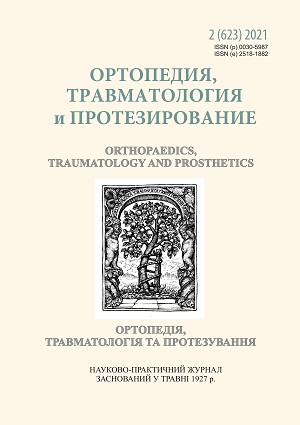Complex revision hip arthroplasty for aseptic implant instability with 3D-modeling
DOI:
https://doi.org/10.15674/0030-59872021258-62Keywords:
Revision arthroplasty, bone defect, 3D-modelAbstract
The increasing number of hip replacement surgeries in the worldwide practice causes the progressive increase in revision cases. The treatment of patients with instability of the hip implants requires the individual approach, taking into account the size of the defect, the loss of bone mass and the structural state of the bone in each case. Objective. To show the technical opportunities of the revision cementless implants in combination with 3D-modeling for the treatment of acetabulum massive defects. Methods. It was shown the clinical case of hip replacement surgery of the patient with the aseptic instability of endoprosthesis components. A 3D-model of the pelvis and femur was created on the basis of the СT scan in order to make an analysis of bone tissue defects and to select the exact size of implant components for revision surgery. Results. It was suggested a standardized methodology of the preoperative examination to make the high-tech operation easier and maximally effective. It is necessary not only to take into account the results of the X- ray analysis, but also to pay attention to all changes in the damaged segments. It was shown that the real plastic model make the work of the surgeon easier during all steps of the treatment. The opportunity to use the standard revision components for the restoration of the complex geometrically shaped bone was demonstrated with the good nearest clinical and radiological and functional results. Conclusions. The success of the revision arthroplasty depends on the carefully preoperative planning, the maximum approximation of the parameters of the artificial joint to the anatomical parameters of the patient and biomechanics of the hip join. No less important is the individual recovery program during the postoperative period.
References
- Filippenko, V. A., & Korzh, N. A. (2015). Endoprosthetics of the hip joint. Kharkiv: Collegium. [in Russian]
- Evans, J. T., Evans, J. P., Walker, R. W., Blom, A. W., Whitehouse, M. R., & Sayers, A. (2019). How long does a hip replacement last? A systematic review and meta-analysis of case series and national registry reports with more than 15 years of follow-up. The Lancet, 393(10172), 647-654. https://doi.org/10.1016/s0140-6736(18)31665-9
- Delaunay, C., Hamadouche, M., Girard, J., & Duhamel, A. (2013). What are the causes for failures of primary hip Arthroplasties in France? Clinical Orthopaedics & Related Research, 471(12), 3863-3869. https://doi.org/10.1007/s11999-013-2935-5
- Paprosky, W. G., Perona, P. G., & Lawrence, J. M. (1994). Acetabular defect classification and surgical reconstruction in revision arthroplasty. The Journal of Arthroplasty, 9(1), 33-44. https://doi.org/10.1016/0883-5403(94)90135-x
- Reid, C., Grobler, G. P., & Dower, B. J. (2012). Revision total hip arthroplasty: Addressing acetabular bone loss. SA Orthopaedic Journal, 11(3), 34–46
- Kosyakov, A. N. (2016). Essays on surgery of the hip joint. 2nd ed. Kiev. [in Russian]
- Gaiko, G. V., Torchinsky, V. P. & Sulima, O. M. (2014). Errors and complications of revision prosthetics in patients with aseptic instability of the acetabular component of the hip arthroplasty. Trauma, 15(1). [in Ukrainian]
- Korzh, M. O., Filipenko, V. A., & Tankut, V. O. (2017). Modern tendencies of using friction pairs in human joint endoprostheses (review of literature and own researches). Journal of the National Academy of Medical Sciences of Ukraine, 23(3–4), 247–255
- Massin, P., & Achour, S. (2017). Wear products of total hip arthroplasty: The case of polyethylene. Morphologie, 101(332), 1-8. https://doi.org/10.1016/j.morpho.2016.06.001
- Broomfield, J. A., Malak, T. T., Thomas, G. E., Palmer, A. J., Taylor, A., & Glyn-Jones, S. (2017). The relationship between polyethylene wear and Periprosthetic Osteolysis in total hip arthroplasty at 12 years in a randomized controlled trial cohort. The Journal of Arthroplasty, 32(4), 1186-1191. https://doi.org/10.1016/j.arth.2016.10.037
- Revell, P. A. (2008). The combined role of wear particles, macrophages and lymphocytes in the loosening of total joint prostheses. Journal of The Royal Society Interface, 5(28), 1263-1278. https://doi.org/10.1098/rsif.2008.0142
- Marsh, A. C., Chamorro, N. P., & Chatzistavrou, X. (2019). Long-term performance and failure of orthopedic devices. Bone Repair Biomaterials, 379-410. https://doi.org/10.1016/b978-0-08-102451-5.00015-9
- Rukin, Y., Kavalerskiy, G., Murylev, V., Elizarov, P., Lychagin, A., & Tselisheva, E. (2018). Three-dimensional models in planning of revision hip arthroplasty with complex acetabular defects. Indian Journal of Orthopaedics, 52(6), 625. https://doi.org/10.4103/ortho.ijortho_556_16
Downloads
How to Cite
Issue
Section
License

This work is licensed under a Creative Commons Attribution 4.0 International License.
The authors retain the right of authorship of their manuscript and pass the journal the right of the first publication of this article, which automatically become available from the date of publication under the terms of Creative Commons Attribution License, which allows others to freely distribute the published manuscript with mandatory linking to authors of the original research and the first publication of this one in this journal.
Authors have the right to enter into a separate supplemental agreement on the additional non-exclusive distribution of manuscript in the form in which it was published by the journal (i.e. to put work in electronic storage of an institution or publish as a part of the book) while maintaining the reference to the first publication of the manuscript in this journal.
The editorial policy of the journal allows authors and encourages manuscript accommodation online (i.e. in storage of an institution or on the personal websites) as before submission of the manuscript to the editorial office, and during its editorial processing because it contributes to productive scientific discussion and positively affects the efficiency and dynamics of the published manuscript citation (see The Effect of Open Access).














